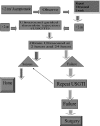Treatment of Iatrogenic Pseudoaneurysms Using Ultrasound-Guided Thrombin Injection over a 5-Year Period
- PMID: 23204825
- PMCID: PMC3331643
- DOI: 10.1055/s-0031-1295521
Treatment of Iatrogenic Pseudoaneurysms Using Ultrasound-Guided Thrombin Injection over a 5-Year Period
Abstract
In this study we demonstrate that ultrasound (US)-guided injection of thrombin is a safe and effective way to treat iatrogenic pseudoaneurysms as a new treatment modality at a 650-bed urban community hospital. We included retrospective chart review of patients who were treated for iatrogenic pseudoaneurysms from January 2004 to June 2010 at a single institution. All patients' pseudoaneurysms were treated using US-guided thrombin injection. This study demonstrated an overall success rate of 97.1% in treating iatrogenic pseudoaneurysms in 33 of 34 patients. One patient underwent open surgical repair. No mortality or complications were noted. The study was successful in demonstrating that the US-guided injection of thrombin is an efficacious way to treat iatrogenic pseudoaneurysms and can be safely implemented as a new treatment modality by appropriately trained vascular surgeons. A review of different techniques is included. An algorithm for the treatment of iatrogenic pseudoaneurysms is proposed from this study.
Keywords: Pseudoaneurysm; false aneurysm; ultrasound-guided thrombin injection.
Figures
References
-
- Franklin J A, Brigham D, Bogey W M, Powell C S. Treatment of iatrogenic false aneurysms. J Am Coll Surg. 2003;197(2):293–301. - PubMed
-
- Kang S S, Labropoulos N, Mansour M A, et al. Expanded indications for ultrasound-guided thrombin injection of pseudoaneurysms. J Vasc Surg. 2000;31(2):289–298. - PubMed
-
- Khoury M, Rebecca A, Greene K, et al. Duplex scanning-guided thrombin injection for the treatment of iatrogenic pseudoaneurysms. J Vasc Surg. 2002;35(3):517–521. - PubMed
-
- Kang S S, Labropoulos N, Mansour M A, Baker W H. Percutaneous ultrasound guided thrombin injection: a new method for treating postcatheterization femoral pseudoaneurysms. J Vasc Surg. 1998;27(6):1032–1038. - PubMed
LinkOut - more resources
Full Text Sources





